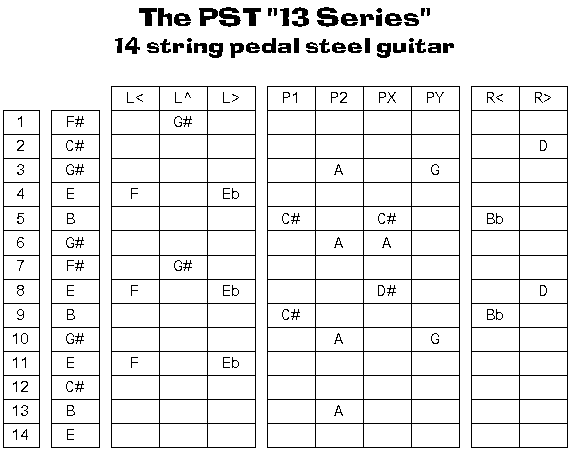by Ed Packard
(Chart also available as plain text)
- I neck = E69
- IV neck (P1 + P2) = A6
- V neck (L>) = B6
- PX => EM13 neck
- PX + R> => E13
- PX + PY + R> => Em13
- PX + PY => Em13M7
The E9 P3 may be added if you like, as can the "BIG B6" changes, ...up to 9+7 with B6 lok.
The PST "13 SERIES" psg
Intervals given for key of E:
str# L< L^ L> P1 P2 R< R> PX PY 1 2,9 ---------4-------------------------------9------- 2 6,13 -----------------------------------b7----6------- 3 3 -----------------------4,11--------------3---b3-- 4 1 ----b9--------7--------------------------1------- 5 5 ------------------6,13--------b5---------13------ 6 3 -----------------------4,11--------------11------ 7 2,9 ---------4-------------------------------9------- 8 1 ----b9--------7--------------------b7----7------- 9 5 ------------------6,13--------b5---------5------- 10 3 -----------------------4,11--------------3---b3-- 11 1 ----b9--------7--------------------------1------- 12 6,13 ----------------------------------------13------ 13 5 -----------------------4,11--------------11------ 14 1 -----------------------------------------1-------
The "13 SERIES" tunings are based upon 7 tone, 2 octave chord theory.
The 7 tones are the "odd" numbered intervals of the diatonic scale.
The 7 tones are "stacked 3rds", ..each note is a 3rd above the preceding tone.
Chords are formed from combining intervals of 3rds, = "odd" numbered intervals.
PX (i use P3 = PX), gives adjacent intervals of 1, 3, 5, 7, 9, 11, 13 in the I neck position on any fret, I.E...fret 0 = EM13, fret 8 = CM13, etc.
The chord spelled by the lines of the treble clef is an M13 chord.
The chord spelled by the spaces of the treble clef is an m13 chord.
Because we have both M13 and m13 chords we have both lines and spaces; we can read sheet music directly onto the strings.
If the key is C, the line notes are C, E, G, B, D, F, A, ..the chord on fret 8 using PX is CM13; the space notes are D, F, A, C, E, G, B, ..the chord on fret 10 using PX + PY + R> is Dm13, so we have both line and space chords.
Let's look at a few of the other chords on fret 8 with PX activated:
- CEG=C, CEGB=CM7, CEGBD=CM9, CEGBDF=CM11, CEGBDFA=CM13.
- EGB=Em, EGBD=Em7, EGBDF=Em7b9, EGBDFA=Em11b9, EGBDFAC=Em11b9b13.
- GBD=G, GBDF=G7, GBDFA=G9, GBDFAC=G11, GBDFACE=G13.
You may wish to finish the chord spelling exercise for fret 8 PX, and then do fret 10 PX + PY + R>.
When you have fininshed, you will see that the major scale for any key may be harmonized in 3, 4, 5, 6, or 7 tone chords using only 2 frets, and alternating between PX, and PX + PY + R>.
Let's partially list the I neck I position tunings:
- PX activated is the key to the 13 series tunings.
- PX provides the M13 tuning.
- PX + R> provides the 13 tuning; R> changes the 7 to b7.
- PX + PY provides the m13 tuning; PY changes the 3 to b3.
- PX + PY + R> provides the m13 tuning.
- PX + P2 provides the M13s4 tuning; P2 changes the 3 to #3 = 4.
- PX + R> + P2 provides the 13s4 tuning.
We have shown the 3rds and 7ths may be flatted (b) and sharped (#), 5ths, 9ths, 11ths, and 13ths may also be flatted and sharped, .. see if you can figure out how, ..(hint, try position IV, and other positions on the I neck).
Audio and video tapes explaining and demonstrating the instrument are available, as are video tapes on music theory, and the evolution of steel guitar tunings.
If you are interested in using the instrument as a controller for the virtual instrument, contact me at the e-mail address given below.
If you have an interest in being set up with a computer system that will provide your own backup band, your key, your style, your tempo, etc, ..contact for assistance.
email address: EPackard@gnn.com
Copyright © Ed Packard 1996.
Permission to reproduce for netpage publishing given to Bobby Lee.
| HTML by Bobby Lee |
